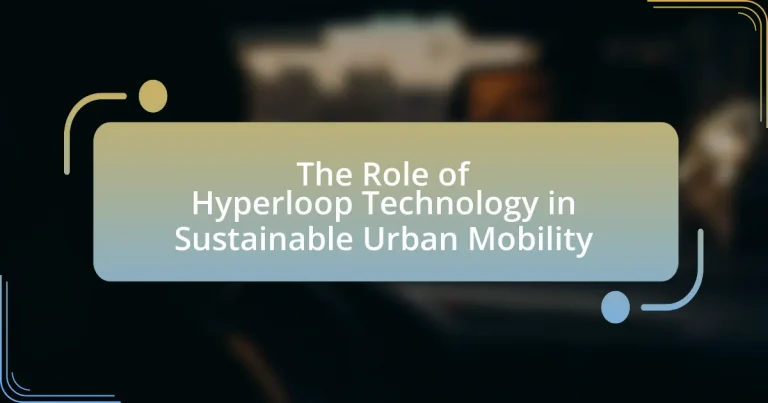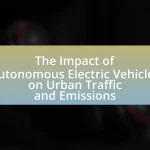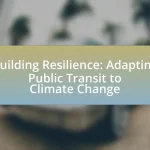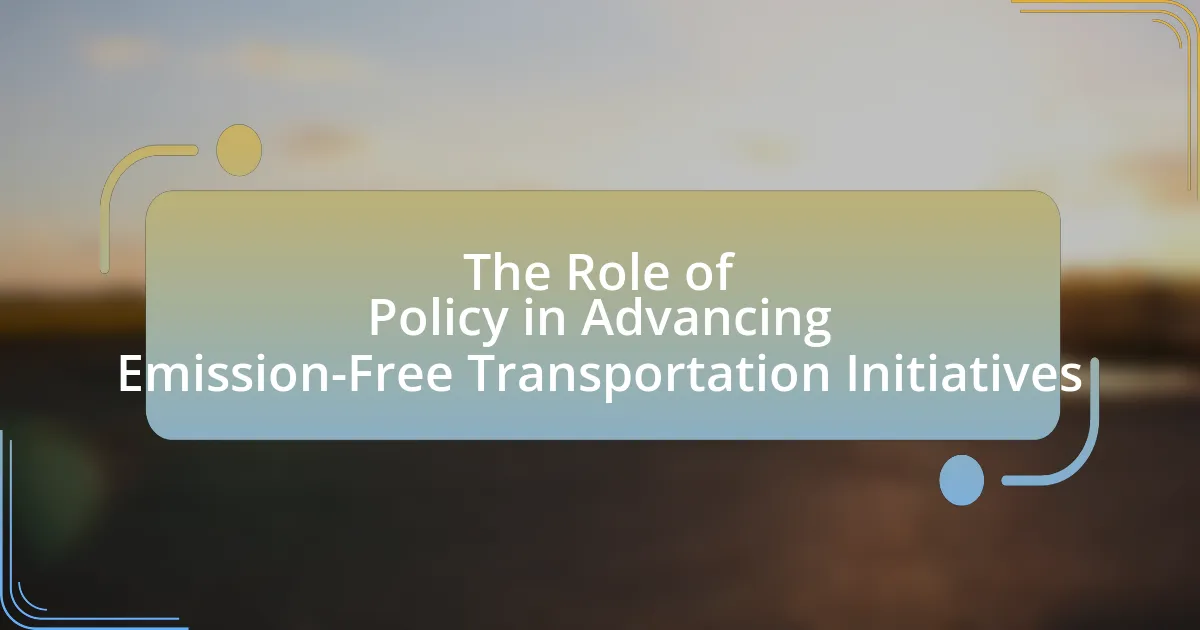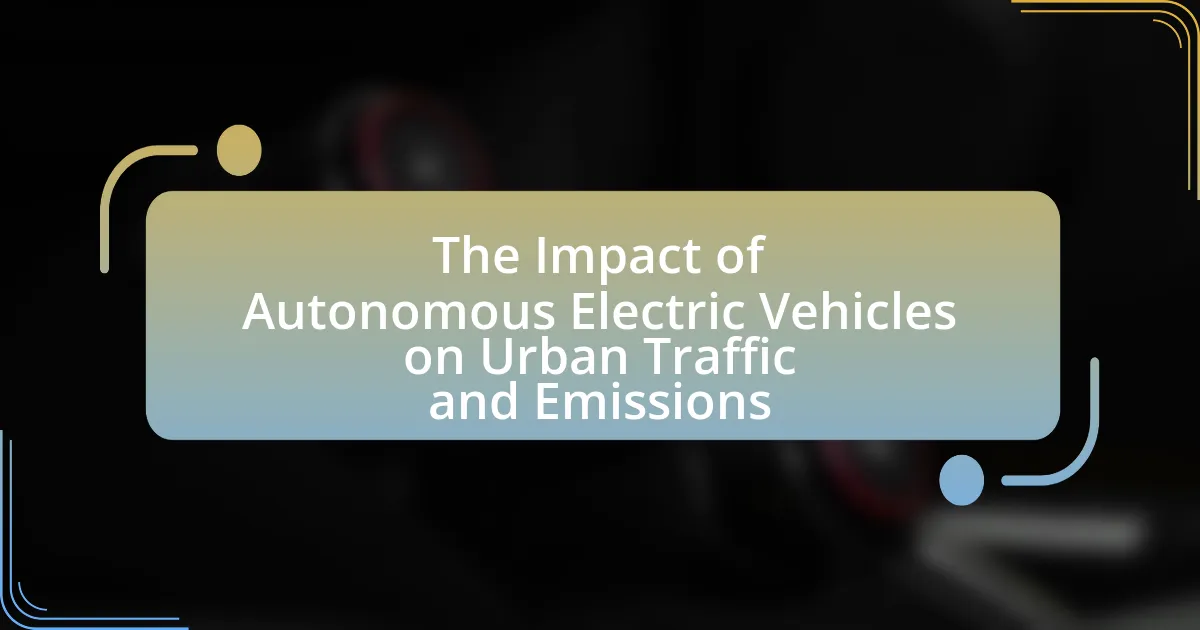Hyperloop technology represents a revolutionary mode of transportation designed to enhance urban mobility by utilizing near-vacuum tubes to transport pods at speeds potentially exceeding 700 miles per hour. This article explores the significance of Hyperloop in urban environments, detailing its operational mechanics, key components, and sustainability benefits, including reduced travel times and lower carbon emissions. It also addresses the challenges of infrastructure costs, regulatory hurdles, and public perception that may impact its implementation. Furthermore, the article examines the potential economic implications, job creation, and the integration of Hyperloop systems into existing transport networks, highlighting its role in shaping future urban planning and development.
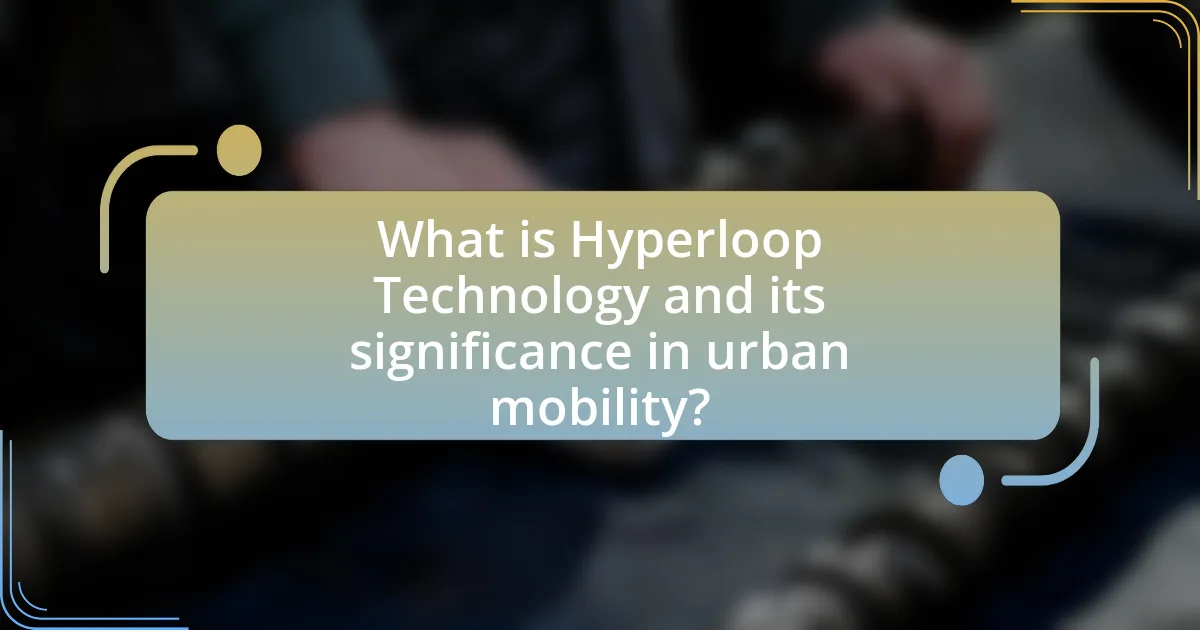
What is Hyperloop Technology and its significance in urban mobility?
Hyperloop technology is a proposed mode of transportation that utilizes a system of near-vacuum tubes to transport pods at high speeds, potentially exceeding 700 miles per hour. Its significance in urban mobility lies in its ability to drastically reduce travel times between cities, alleviate congestion on existing transportation networks, and lower carbon emissions compared to traditional modes of transport. For instance, a Hyperloop system could connect urban centers like Los Angeles and San Francisco in under 30 minutes, compared to several hours by car or train, thereby enhancing accessibility and efficiency in urban environments.
How does Hyperloop Technology function?
Hyperloop technology functions by utilizing a system of low-pressure tubes through which specially designed pods travel at high speeds. The pods are levitated using magnetic levitation or air bearings, significantly reducing friction and allowing for rapid transit. This technology aims to achieve speeds exceeding 700 miles per hour, making it a potential alternative to traditional rail and air travel. The low-pressure environment within the tubes minimizes air resistance, further enhancing efficiency. Hyperloop systems are designed to be energy-efficient, often powered by renewable energy sources, contributing to sustainable urban mobility.
What are the key components of Hyperloop systems?
The key components of Hyperloop systems include the pod, the tube, the propulsion system, and the vacuum environment. The pod is the vehicle that transports passengers or cargo, designed for aerodynamic efficiency. The tube is a low-pressure environment that minimizes air resistance, allowing for high-speed travel. The propulsion system, often based on magnetic levitation or linear motors, accelerates the pod along the tube. The vacuum environment reduces air pressure to near-zero levels, further decreasing drag and enabling faster speeds. These components work together to create a sustainable and efficient mode of transportation, aiming to reduce travel times and energy consumption compared to traditional systems.
How does the technology ensure high-speed travel?
Hyperloop technology ensures high-speed travel by utilizing low-pressure tubes that minimize air resistance and magnetic levitation systems that reduce friction. The low-pressure environment allows pods to travel at speeds exceeding 700 miles per hour, as demonstrated in various feasibility studies and prototype tests. Additionally, the magnetic levitation system enables smooth acceleration and deceleration, further enhancing travel efficiency. These elements combined create a transportation system capable of significantly reducing travel times between urban centers, supporting sustainable urban mobility initiatives.
Why is Hyperloop Technology considered sustainable?
Hyperloop technology is considered sustainable because it utilizes renewable energy sources and has a low environmental impact compared to traditional transportation methods. The system is designed to operate on electricity, which can be generated from solar or wind energy, significantly reducing greenhouse gas emissions. Additionally, Hyperloop’s streamlined design minimizes land use and energy consumption, allowing for efficient travel with reduced noise pollution. Studies indicate that Hyperloop could achieve energy efficiency levels that are several times greater than those of current rail systems, further supporting its sustainability credentials.
What environmental benefits does Hyperloop offer compared to traditional transport?
Hyperloop offers significant environmental benefits compared to traditional transport by reducing energy consumption and greenhouse gas emissions. The system operates on electric power, which can be sourced from renewable energy, leading to a lower carbon footprint. For instance, studies indicate that Hyperloop could achieve energy efficiency levels up to 10 times greater than that of conventional rail systems. Additionally, Hyperloop’s design minimizes land use and habitat disruption, as it can be constructed above ground or in existing transportation corridors, preserving natural landscapes. This innovative transport solution thus contributes to sustainable urban mobility by promoting cleaner, more efficient travel options.
How does Hyperloop Technology reduce carbon emissions?
Hyperloop technology reduces carbon emissions by utilizing electric propulsion and a vacuum environment that minimizes air resistance. This system allows for high-speed travel with significantly lower energy consumption compared to traditional transportation methods, such as cars and airplanes, which rely on fossil fuels. For instance, studies indicate that Hyperloop systems can operate with renewable energy sources, further decreasing their carbon footprint. Additionally, the efficient design and infrastructure of Hyperloop systems can lead to a reduction in overall vehicle miles traveled, contributing to lower greenhouse gas emissions in urban areas.
What challenges does Hyperloop Technology face in urban mobility?
Hyperloop technology faces significant challenges in urban mobility, primarily related to infrastructure costs, regulatory hurdles, and public acceptance. The construction of Hyperloop systems requires substantial investment, with estimates suggesting costs could reach billions of dollars per mile, making it financially daunting for urban planners. Additionally, navigating the complex regulatory landscape poses obstacles, as Hyperloop systems must comply with various safety and zoning regulations, which can delay implementation. Public acceptance is another critical challenge; studies indicate that new transportation technologies often face skepticism from communities concerned about noise, safety, and environmental impact. These factors collectively hinder the widespread adoption of Hyperloop technology in urban settings.
What are the regulatory hurdles for Hyperloop implementation?
The regulatory hurdles for Hyperloop implementation include safety standards, land use regulations, and environmental impact assessments. Safety standards must be established to ensure passenger safety and system reliability, which can be complex due to the innovative nature of Hyperloop technology. Land use regulations pose challenges as Hyperloop systems require significant infrastructure, often necessitating negotiations with local governments and property owners. Environmental impact assessments are required to evaluate the potential effects on ecosystems and communities, which can lead to lengthy approval processes. These regulatory challenges can delay project timelines and increase costs, as seen in other large-scale transportation projects.
How does public perception impact the adoption of Hyperloop Technology?
Public perception significantly impacts the adoption of Hyperloop technology by influencing public support, investment, and regulatory approval. Positive public perception can lead to increased demand for the technology, prompting governments and private investors to allocate resources for its development. For instance, surveys indicate that public enthusiasm for innovative transportation solutions correlates with higher funding opportunities; a 2021 study by the International Transport Forum found that 70% of respondents favored investment in new transport technologies when they perceived them as safe and environmentally friendly. Conversely, negative perceptions, often stemming from safety concerns or skepticism about feasibility, can hinder progress, as seen in the initial public resistance to other transformative technologies like high-speed rail. Thus, shaping a favorable public perception is crucial for the successful implementation and widespread acceptance of Hyperloop technology in sustainable urban mobility.
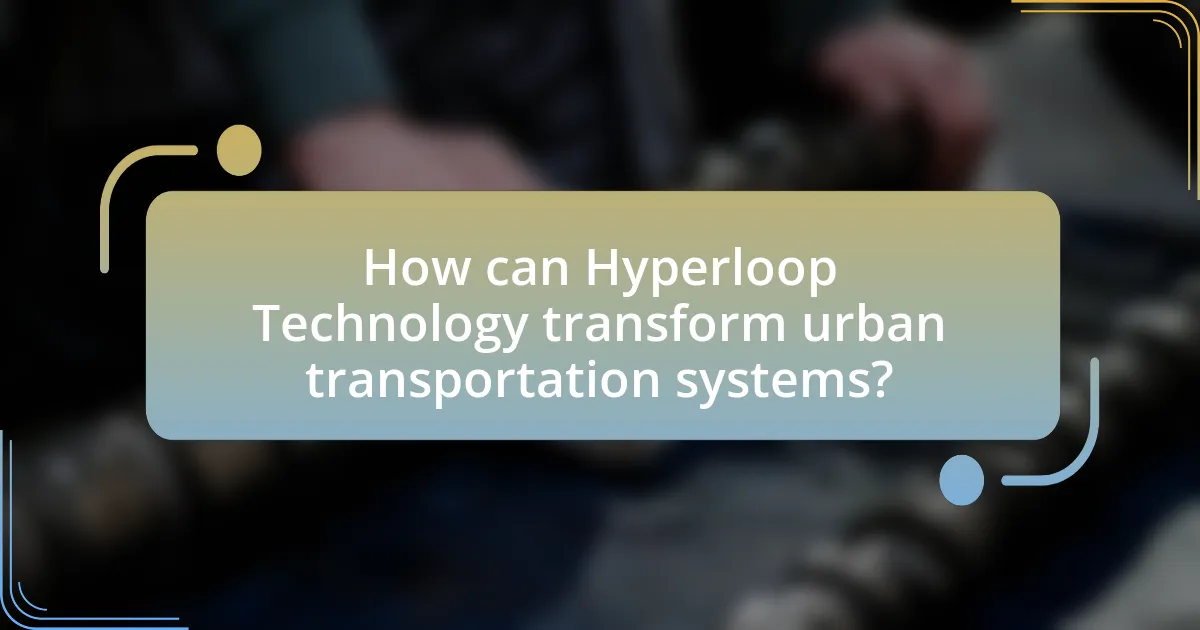
How can Hyperloop Technology transform urban transportation systems?
Hyperloop technology can transform urban transportation systems by enabling high-speed travel between cities and reducing congestion in metropolitan areas. This innovative mode of transport operates in low-pressure tubes, allowing pods to travel at speeds exceeding 700 miles per hour, significantly faster than traditional rail or road transport. For instance, a journey between Los Angeles and San Francisco could be completed in under 30 minutes, compared to several hours by car or train.
Additionally, Hyperloop systems are designed to be energy-efficient and environmentally friendly, utilizing renewable energy sources and producing minimal emissions. This aligns with sustainable urban mobility goals, as cities increasingly seek to reduce their carbon footprints and improve air quality. The implementation of Hyperloop technology could lead to a decrease in reliance on fossil fuel-powered vehicles, thereby contributing to a more sustainable urban transportation ecosystem.
What are the potential impacts of Hyperloop on urban congestion?
Hyperloop technology has the potential to significantly reduce urban congestion by providing a high-speed, efficient alternative to traditional transportation methods. By enabling rapid transit between urban centers, Hyperloop can decrease the reliance on cars and buses, which are major contributors to traffic congestion. For instance, a Hyperloop system could connect cities within a 500-mile radius in under an hour, effectively shortening travel times and reducing the volume of vehicles on the road. This shift could lead to a decrease in traffic jams and lower emissions, as fewer vehicles would be needed for the same number of commuters. Studies suggest that implementing Hyperloop could lead to a 30% reduction in urban traffic congestion in areas where it is deployed, demonstrating its potential effectiveness in transforming urban mobility.
How does Hyperloop Technology integrate with existing transport networks?
Hyperloop technology integrates with existing transport networks by providing high-speed connections that complement traditional modes of transportation, such as trains, buses, and airports. This integration allows for seamless transfers between Hyperloop stations and existing transport hubs, enhancing overall mobility. For instance, Hyperloop systems can be designed to connect directly to major train stations or airports, facilitating efficient passenger movement and reducing travel times. Additionally, studies indicate that Hyperloop can alleviate congestion in urban areas by offering an alternative to road travel, thus supporting sustainable urban mobility initiatives.
What role does Hyperloop play in reducing travel times in cities?
Hyperloop significantly reduces travel times in cities by enabling high-speed transportation through low-pressure tubes, allowing pods to travel at speeds exceeding 700 miles per hour. This technology can drastically shorten the duration of intercity commutes, making it feasible to travel distances that currently take hours in mere minutes. For instance, a journey from Los Angeles to San Francisco, which typically takes about six hours by car, could be completed in approximately 30 minutes using Hyperloop. This capability not only enhances connectivity between urban areas but also alleviates congestion on existing transportation networks, thereby improving overall urban mobility.
How does Hyperloop Technology influence urban planning and development?
Hyperloop technology significantly influences urban planning and development by enabling faster, more efficient transportation between cities, which can reshape urban landscapes. This technology allows for the reduction of travel times, making previously distant areas more accessible, thus encouraging the development of new urban centers and the expansion of existing ones. For instance, a study by the Massachusetts Institute of Technology (MIT) highlighted that Hyperloop could reduce travel time between major cities like Los Angeles and San Francisco to about 30 minutes, which would lead to increased economic activity and population growth in surrounding areas. Additionally, the integration of Hyperloop systems into urban infrastructure promotes sustainable development by reducing reliance on cars and lowering greenhouse gas emissions, aligning with modern urban planning goals focused on sustainability and efficiency.
What are the implications for land use and infrastructure development?
The implications for land use and infrastructure development due to Hyperloop technology include the potential for reduced land consumption and the reconfiguration of urban spaces. Hyperloop systems require less land than traditional rail or road networks, allowing for more efficient use of urban areas. This efficiency can lead to the repurposing of existing infrastructure, such as converting old rail lines into Hyperloop routes, which can minimize disruption and promote sustainable development. Furthermore, studies indicate that Hyperloop could significantly decrease travel times between cities, influencing urban planning by encouraging higher density development around Hyperloop stations, thereby fostering transit-oriented development. This shift can lead to more sustainable urban environments, as seen in projects that integrate high-speed transit with mixed-use developments, promoting walkability and reducing reliance on personal vehicles.
How can Hyperloop contribute to the creation of smart cities?
Hyperloop can significantly contribute to the creation of smart cities by providing high-speed, efficient transportation that reduces congestion and lowers carbon emissions. This innovative transport system operates in low-pressure tubes, allowing pods to travel at speeds exceeding 700 miles per hour, which can drastically cut travel times between urban centers. For instance, a journey from Los Angeles to San Francisco could take under 30 minutes, promoting economic connectivity and reducing reliance on traditional vehicles. Additionally, Hyperloop’s energy-efficient design utilizes renewable energy sources, aligning with smart city goals of sustainability and reduced environmental impact. By integrating Hyperloop into urban planning, cities can enhance mobility, improve air quality, and foster economic growth, ultimately contributing to the development of smarter, more sustainable urban environments.
What are the economic implications of adopting Hyperloop Technology?
Adopting Hyperloop Technology has significant economic implications, primarily through reduced transportation costs and increased efficiency. The Hyperloop system is projected to lower travel times between major urban centers, which can enhance productivity and stimulate economic growth in those regions. For instance, a study by the International Transport Forum estimates that high-speed transport systems like Hyperloop could reduce travel costs by up to 50% compared to traditional rail systems. Additionally, the construction and operation of Hyperloop infrastructure could create thousands of jobs, contributing to local economies. Furthermore, the potential for increased connectivity may lead to urban expansion and development, driving further economic activity.
How does Hyperloop Technology create job opportunities in urban areas?
Hyperloop Technology creates job opportunities in urban areas by stimulating infrastructure development and attracting investment. The construction and maintenance of Hyperloop systems require a skilled workforce, leading to jobs in engineering, construction, and technology sectors. For instance, the development of Hyperloop routes necessitates the hiring of thousands of workers, as seen in projects like Virgin Hyperloop, which has projected the creation of over 600,000 jobs in the U.S. alone. Additionally, the operational phase of Hyperloop systems will generate ongoing employment in areas such as transportation management, customer service, and maintenance, further contributing to local economies.
What are the potential costs and funding models for Hyperloop projects?
The potential costs for Hyperloop projects are estimated to range from $20 million to $100 million per mile, depending on various factors such as technology, land acquisition, and construction methods. Funding models for these projects typically include public-private partnerships, government grants, and private investment. For instance, the Virgin Hyperloop project has received significant funding from private investors and partnerships with government entities, demonstrating a viable model for financing such large-scale infrastructure. Additionally, the use of innovative financing mechanisms, like green bonds, is being explored to attract environmentally conscious investors, further supporting the financial viability of Hyperloop initiatives.
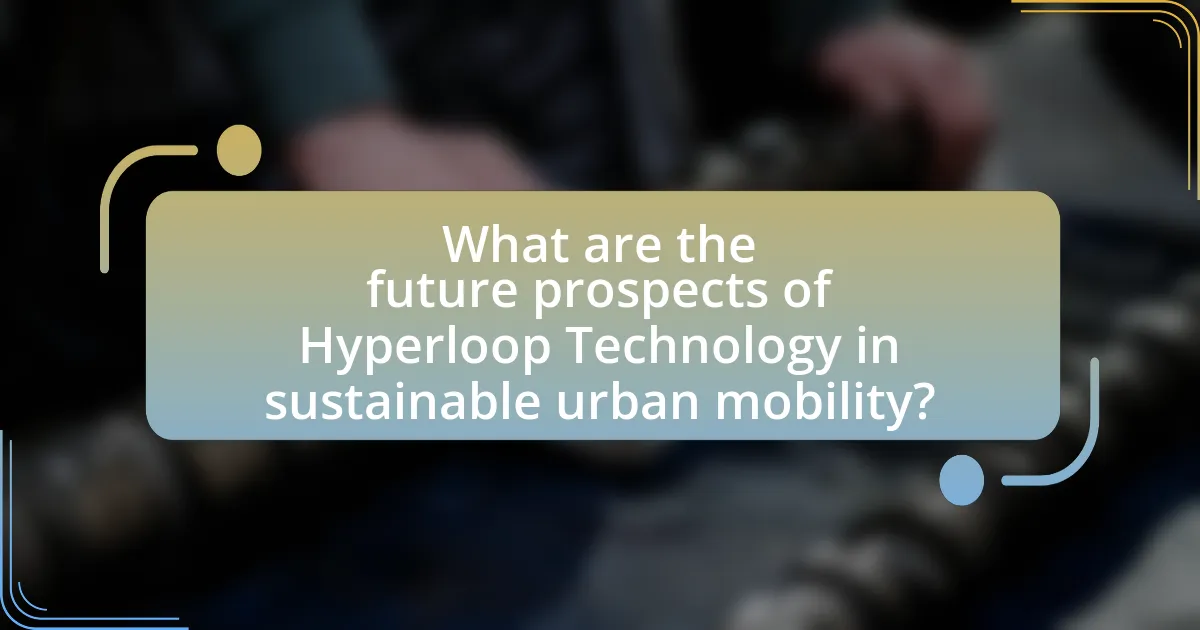
What are the future prospects of Hyperloop Technology in sustainable urban mobility?
The future prospects of Hyperloop technology in sustainable urban mobility are promising, as it offers a high-speed, energy-efficient transportation alternative that can significantly reduce urban congestion and carbon emissions. Hyperloop systems are designed to operate using renewable energy sources, potentially achieving energy efficiency levels that are much higher than traditional rail and road transport. For instance, a study by the International Transport Forum indicates that Hyperloop could reduce travel times between major urban centers to under 30 minutes while using less energy per passenger mile compared to conventional transport methods. This aligns with global sustainability goals, making Hyperloop a viable solution for future urban mobility challenges.
How is the development of Hyperloop Technology progressing globally?
The development of Hyperloop technology is progressing with significant advancements and investments globally. Companies like Virgin Hyperloop and Elon Musk’s The Boring Company are actively conducting tests and developing prototypes, with Virgin Hyperloop successfully completing passenger tests in 2020. Additionally, various governments and private entities are exploring feasibility studies and potential routes, such as the proposed Hyperloop system in India, which aims to connect major cities and reduce travel time drastically. These efforts indicate a growing interest in Hyperloop as a viable mode of sustainable urban mobility, supported by ongoing research and investment in infrastructure.
What are the leading countries and companies involved in Hyperloop projects?
The leading countries involved in Hyperloop projects include the United States, India, and the United Arab Emirates. In the United States, companies like Virgin Hyperloop and Elon Musk’s The Boring Company are at the forefront of development. India is pursuing Hyperloop technology through a collaboration with Virgin Hyperloop for a proposed route between Mumbai and Pune. The United Arab Emirates is advancing its Hyperloop initiatives with the support of Virgin Hyperloop, focusing on a route connecting Abu Dhabi and Dubai. These countries and companies are actively working on the feasibility, design, and implementation of Hyperloop systems, showcasing significant investment and innovation in this transportation technology.
How do technological advancements influence the future of Hyperloop?
Technological advancements significantly influence the future of Hyperloop by enhancing its efficiency, safety, and feasibility. Innovations in materials science, such as the development of lightweight composites, improve the structural integrity and reduce the energy consumption of Hyperloop systems. Additionally, advancements in magnetic levitation technology enable smoother and faster travel, potentially reaching speeds of over 700 miles per hour. Furthermore, improvements in energy storage and renewable energy integration, such as solar panels and battery technology, allow Hyperloop systems to operate sustainably, aligning with urban mobility goals. These advancements collectively contribute to making Hyperloop a viable alternative to traditional transportation methods, addressing urban congestion and reducing carbon emissions.
What lessons can be learned from other transportation innovations?
Lessons from other transportation innovations highlight the importance of efficiency, sustainability, and user-centric design. For instance, the introduction of electric vehicles (EVs) has demonstrated that reducing emissions can be achieved through technological advancements, as evidenced by a 2020 report from the International Energy Agency showing that EV sales increased by 43% despite the pandemic. Additionally, the success of bike-sharing programs in cities like Amsterdam illustrates the value of integrating alternative modes of transport to alleviate congestion and promote healthier lifestyles. These examples underscore the necessity of adopting innovative solutions that prioritize environmental impact and user experience, which are critical for the successful implementation of Hyperloop technology in sustainable urban mobility.
How can past experiences shape the implementation of Hyperloop Technology?
Past experiences in transportation projects can significantly shape the implementation of Hyperloop Technology by providing valuable lessons in engineering, safety, and public acceptance. Historical examples, such as the development of high-speed rail systems in countries like Japan and France, demonstrate the importance of rigorous testing and regulatory compliance, which can inform Hyperloop’s safety protocols. Additionally, past failures in transportation projects, such as the Concorde’s operational challenges, highlight the necessity of addressing public concerns and environmental impacts, guiding Hyperloop developers to prioritize sustainability and community engagement. These insights can lead to more effective design, implementation strategies, and ultimately, a higher likelihood of successful adoption in urban mobility contexts.
What best practices can be adopted for successful Hyperloop projects?
Successful Hyperloop projects can be achieved by adopting best practices such as rigorous feasibility studies, stakeholder engagement, and iterative design processes. Rigorous feasibility studies ensure that technical, economic, and environmental aspects are thoroughly evaluated, as demonstrated by the Hyperloop One feasibility study in 2017, which assessed potential routes and costs. Engaging stakeholders, including local communities and government entities, fosters collaboration and addresses concerns, as seen in the public consultations conducted by Virgin Hyperloop. Iterative design processes allow for continuous improvement and adaptation based on testing and feedback, which is crucial for addressing challenges in technology and infrastructure. These practices collectively enhance the likelihood of successful implementation and integration of Hyperloop systems into sustainable urban mobility frameworks.
What practical steps can cities take to prepare for Hyperloop integration?
Cities can prepare for Hyperloop integration by conducting feasibility studies to assess potential routes and infrastructure needs. These studies should analyze existing transportation networks, population density, and economic impact, ensuring alignment with urban development plans. Additionally, cities should engage in public-private partnerships to secure funding and expertise, as seen in projects like the Virgin Hyperloop, which has collaborated with various stakeholders to advance its technology. Furthermore, cities must update zoning laws and land use regulations to accommodate Hyperloop stations and related facilities, facilitating seamless integration into the urban landscape. Lastly, public outreach and education campaigns are essential to inform citizens about the benefits and implications of Hyperloop technology, fostering community support and participation in the planning process.
